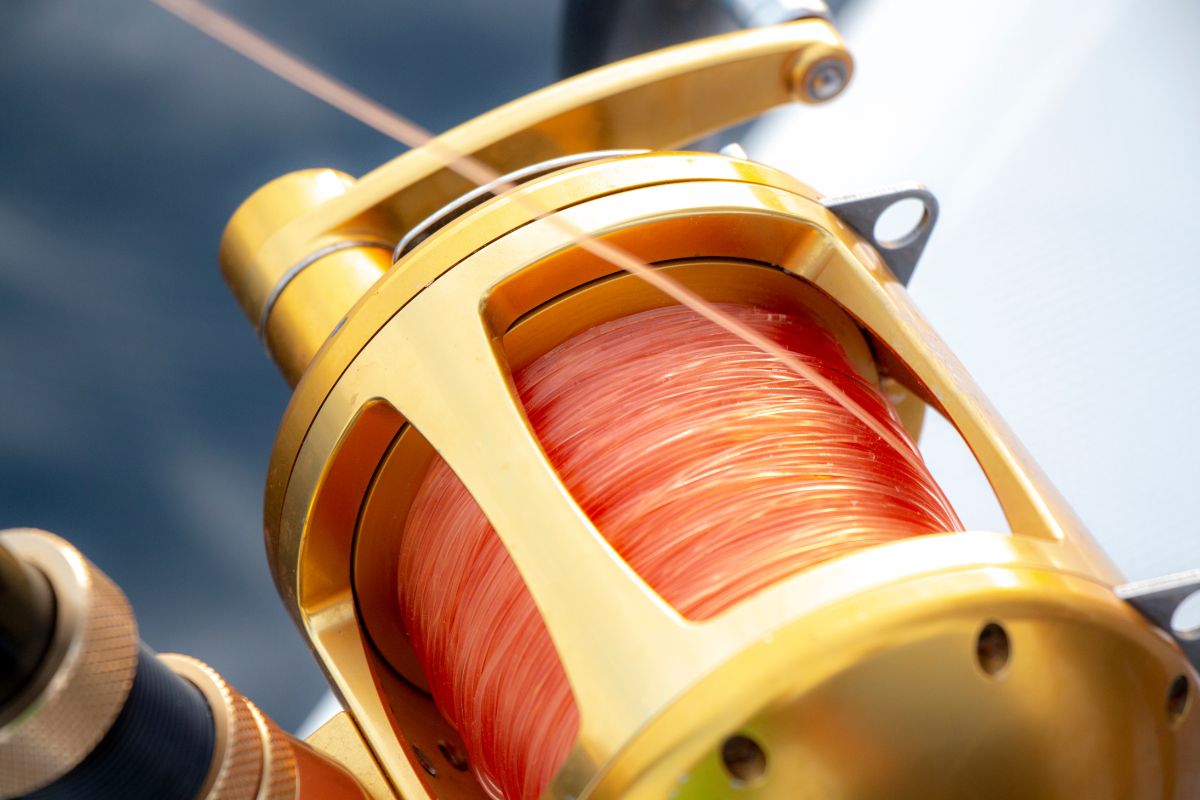The rod, reel, and lure are the sexy components of your fishing rig, but having the best fishing line for your needs might top them all.
You know the frustrating, tell-tale signs that you’ve got bad line:
- Doesn’t sit right in the water
- Unravels on the reel
- Doesn’t cast far enough
- Not enough give and your line snaps
- Too much give and it’s not sensitive enough
- Knots you want won’t hold
- Knots you don’t want keep appearing
We’ve all been there before. The list goes on.
The solution?
Find the right fishing line for you!
This article is intended to be a mid-level dive into the world of fishing line. I’ll give you enough detail to decide which is the best fishing line for you, but not so much detail that you get bored.
Table Of Contents
Best Fishing Line: Quick Picks
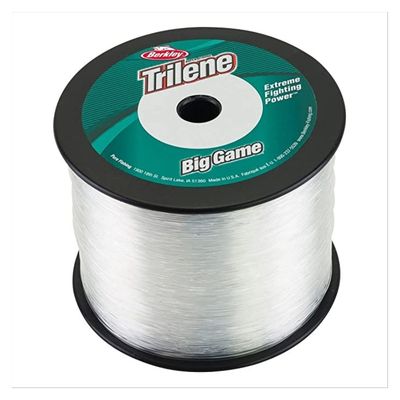
BEST MONOFILAMENT FISHING LINE
Trilene Big Game Line
BERKLEY
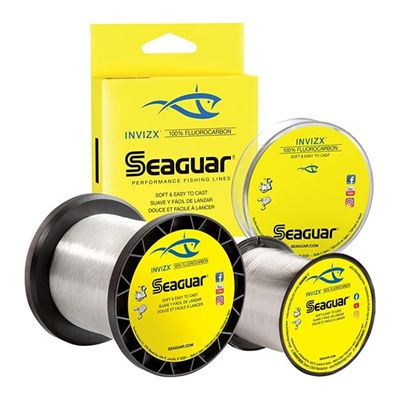
BEST FLUOROCARBON FISHING LINE
INVIZK FLuorocarbon Line
SEAGUAR
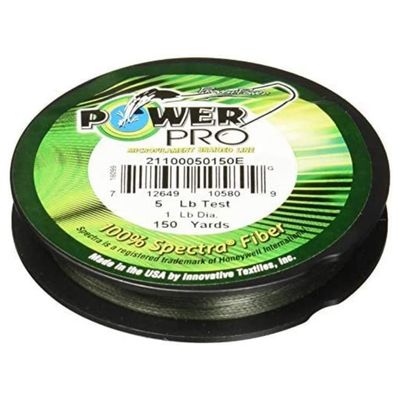
BEST BRAIDED FISHING LINE
Braided Spectra Fiber Line
POWER PRO
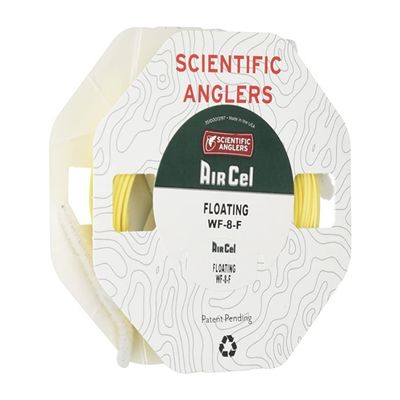
BEST FLY FISHING LINE
AirCel Floating Line
SCIENTIFIC ANGLERS
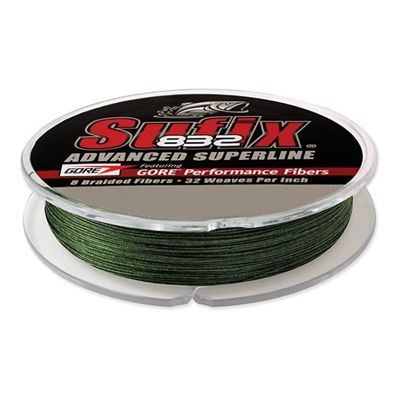
BEST SALTWATER FISHING LINE
832 Advanced Braided Superline
SUFFIX
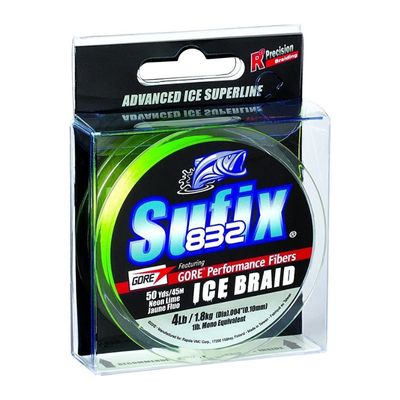
BEST SALTWATER FISHING LINE
832 Ice Braided Line
SUFFIX
The 3 Types of Fishing Line
While there are a ton of different fishing environments, which may have you Googling things like “best fly fishing line” or “best saltwater fishing line,” they’re all just different uses, which will be one of these 3 types:
- Monofilament: Single thread, usually nylon, lowest strength, most flexible, least expensive
- Fluorocarbon: Single thread, more durable, low stretch, low visibility, more expensive
- Braided: Woven microfilaments, best strength-to-diameter, more durable, more expensive
That’s the quick and dirty summary. Keep reading if you want to know more about each type, or just skip to the “Best Fishing Lines” section below.
Monofilament Fishing Line
Even if you’ve never studied the etymology of the English language, you’re probably familiar with what the prefix “mono” means:
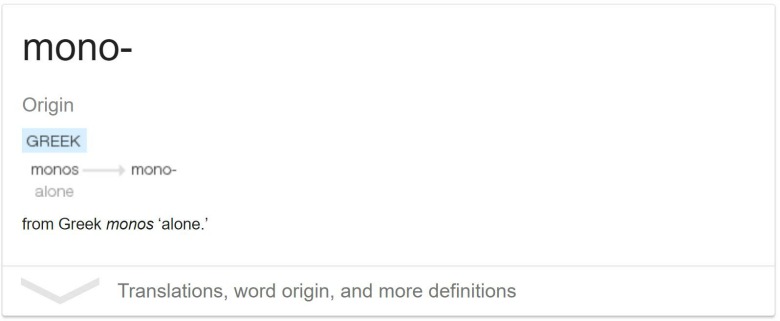
A “filament” is a thin, threadlike object. Combine the two and what do you think monofilament fishing line is?
That’s right! Thin fishing line made up of a single thread.
This is a good time to do a quick compare and contrast with monofilament vs flurocarbon fishing line.
Have you ever heard the expression, “Not all rectangles are squares but all squares are rectangles”? That’s like monofilament and fluorocarbon fishing line; not all monofilament fishing line is fluorocarbon, but all flurocarbon fishing line is monofilament.
(Braided fishing line is made of other stuff. Again, I’ll explain shortly.)
Monofilament fishing line is typically made of 3 different plastics:
- Nylon
- Fluorocarbon
- Bioabsorbable polymer
From here on out, when I refer to “monofilament fishing line” I’ll be talking about nylon. I want to give fluorocarbon its own section, and bioabsorbable polymers are new within the last 10 years and have serious environmental benefits.
Bioabsorbable polymers are made of the same stuff as dissolving stitches and lessen the impact of lost/snagged fishing line on the environment. Standard fluorocarbon fishing line takes 4,000 years to dissolve! Bioabsorbable polymer fishing line takes just 5 years.
The downside? Bioabsorbable fishing line is more expensive than nylon monofilament line. Actually, it’s comparable in price to fluorocarbon line but doesn’t come in knotless, tapered leaders so you’ll have to buy bioabsorbable leader material to make your own.
Let’s look at the pros and cons of nylon monofilament fishing line.
Pros of Nylon Monofilament Fishing Line
- Less visible than braided line
- Superior for knotmaking
- Great shock strength due to stretchiness
- Least expensive type of line
- Less dense than water (if you want to dead drift, etc.)
Cons of Nylon Monofilament Fishing Line
- More visible than fluorocarbon line
- Weaker than fluorocarbon for the same thickness
- Absorbs water through the day, causing further weakness
- Susceptible to the elements, such as UV rays
Fluorocarbon Fishing Line
As mentioned previously, fluorocarbon fishing line technically is a monofilament fishing line. But it’s different enough that it deserves its owns section.
First, what is fluorocarbon?
Because fluorocarbon line is denser than monofilament line, it weighs more for the same thickness. It also has nearly the same refractive index as water, which means it has extremely low visibility. That’s important because it means thicker (stronger) line can be used without sacrificing stealth.
You’ll also often read that fluorocarbon line doesn’t stretch. This isn’t true! OK, it’s partly true. Under low tension conditions, fluorocarbon line doesn’t stretch (whereas nylon monofilament line does). But under more moderate tension, you’ll get some stretch. When does stretchiness matter? It can be crucial in hooksetting, especially when you’re doing so at long distances.
Pros of Fluorocarbon Fishing Line
- Very low visibility so you can use thicker line and get more strength
- High abrasion resistance
- Waterproof for all day usage
- More sensitive which means easier for you to feel what’s happeing at the end of the line
Cons of Fluorocarbon Fishing Line
- Sinks more quickly than nylon monofilament line so not good for topwater lures
- Line must be wet before knotting
- Lack of stretchiness means lower shock strength and greater risk of snapped line
- More expensive than nylon monofilament line
Braided Fishing Line
Whereas monofilament line has a single thread, braided line is made up of many threads (duh).
How is braided line made?
Note that I said woven and not just wrapped around each other.
When you think of braided fishing lines, you may be thinking about big, bulky, thick line made up from strands of micorfilament line woven together. I mean, how can that possibly be thin?
Well, these following two lines have the exact same width:
- 40 lb monofilament test line (0.60mm)
- 100 lb 4-carrier braided test line (0.60mm)
This is a good spot to talk about braided line terminology.
- 4-Carrier vs 8-Carrier: The number of microfilaments being woven together is the “carrier count.” In general, the same thickness of 8-carrier line will be twice as strong as the same thickness of 4-carrier line, assuming the same pic count and brand.
- Pic Count: A “pic” is a point where the woven microfilaments intersect. A “pic count” is how many pics exist in the line per inch. In general, a higher pic count will be stronger, assuming the same carrier count and brand.
Braided line is ideal when strength is paramount.
Pros of Braided Fishing Line
- Most strength for thickness means thinner diameters and more line on your spool
- Superior durability
- Zero stretch means incredible line sensitivity
Cons of Braided Fishing Line
- Harder to knot so must learn knotmaking
- Higher visibility for same diameter compared to both nylon monofilament and fluorocarbon line
- Most expensive type of fishing line
18 Best Fishing Lines For 2023
Now that you know the difference between the 3 types of fishing line, let’s name the 18 best fishing line choices across 6 different categories:
- Best monofilament fishing line
- Best fluorocarbon fishing line
- Best braided fishing line
- Best fly fishing line
- Best saltwater fishing line
- Best ice fishing line
As with all of our posts here on The Outdoor Authority, I want to hear from you! Best fishing line is subjective. Do you have a favorite saltwater fishing line that I didn’t mention? Comment below!
Best Monofilament Fishing Line
Berkley Trilene Big Game Line

Best For: Saltwater big game fishing
A clear line that comes in 30-100 lb test, the Berkley Trilene Big Game Line has superior shock strength and is a proven monofilament line among big game anglers in all conditions — saltwater and freshwater. It’s a wide-diameter monofilament line, which makes it more visible than similar test fluorocarbon or braided lines, but it’s also much stronger than most monofilament lines.
Maxima Line Maxi Spool
Best For: Trout or panfish where high abrasion resistance is required
Ultra green line in 4-12 lb test, the Maxima Line Maxi Spool functions at the other end of the spectrum from the Berkley Trilene Big Game Line above. It has advanced light diffusing properties, which makes it less visible than most monofilament lines, and has great knot strength and durability.
ANDE Back Country
Best For: Saltwater trolling
In either green or blue and ranging from 6-50 lb test, ANDE Back Country line has amazingly low memory yet great durability for saltwater use. In particular this line has low line twist, which makes it ideal for trolling.
Best Fluorocarbon Fishing Line
Seaguar INVIZX Fluorocarbon Fishing Line

Best For: Large freshwater fish like walleye and northern pike
Clear line from 6-20 lb test, Seaguar INVIZX Fluorocarbon line is designed for invisibility in freshwater. (Took me a second to realized “INVIZX” is supposed to be some cool marketing slang for “invisible…x?”) This line is intended for casting or spinning reels. It’s easier to knot than most fluorocarbon lines and is a tried and true line for walleye and northern pike.
P-Line Floroclear Line
Best For: Clear freshwater environments and making fluorocarbon leaders
Clear line with a 25 lb test, P-Line Floroclear Line has low memory for a fluorocarbon line and is virtually invisible. It works great either as the only line you use or as a fluorocarbon leader thanks to its great knotmaking ability (by fluorocarbon standards).
Sunline Super FC Sniper Fluorocarbon Line
Best For: Deepwater bass fishing
Clear line from 2-25 lb test, Sunline Super FC Sniper has more weight and sinks well for deepwater bass fishing. Like most fluorocarbon lines is has great strength for its diameter and is durable and highly sensitive.
Best Braided Fishing Line
PowerPro Braided Spectra Fiber Micro Filament Line

Best For: Honestly, any kind of fishing
Comes in shades of yellow, green, and red from 5-150 lb test, PowerPro Braided Spectra is truly one of the most versatile fishing lines. As mentioned in the braided fishing line section above, braided line has fantastic strength-to-diameter with PowerPro Braided Spectra 100 lb test line having the same diameter as 20 lb monofilament test line. Honestly, this stuff is phenomenal for any kind of fishing.
Berkley FireLine Fused Crystal Fishing Line
Best For: Fishing in the weeds with a spinning reel
Crystal colored (basically white) from 2-30 lb test, Berkley Fireline Fused Crystal offers amazing castability and smoothness while still maintaining the signature abrasion resistance and strength of braided line. Despite its thin diameter it’s surprisingly resistant to looping and wind knots with low line twisting.
Western Filament Tuf Line XP
Best For: Anglers looking for braided line on a budget
Green line from 8-65 lb test, Western Filament Tuf Line XP lives up to the “Tuf” in its name. The green color does fade to white fairly quickly (maybe even in one trip), though I don’t think that markedly affects performance. Like all braided line you get great strength and durability for the thickness. This one just serves as a more discount alternative.
Best Fly Fishing Line
If you’re into fly fishing, check out The Complete Guide to Fly Fishing Waders.
Scientific Anglers AirCel Floating Line

Best For: Most types of fly fishing
Yellow weight-forward line from 4-F to 9-F, Scientific Anglers AirCel Floating Line has a braided core and measures 80 feet long. As any fisherman knows, Scientific Angler is a proven brand that makes great stuff, and these lines vary in weight from 4 (good for panfish) to 9 (good for almost anything smaller than tarpon or billfish).
Piscifun Sword Weight Forward Floating Fly Fishing Line with Welded Loop
Best For: Fly fishermen looking for a longer line that’s easier to cast
Sky blue weight-forward line ranging from 3-F to 8-F and 90-100 feet long, Piscifun Sword Weight Forward Line features a longer head, larger diameter, and slick PVC coating, which makes it much easier to cast. It’s a braided, low memory line that gives you a longer line for a competitive price.
KastKing Exergy Fly Fishing Line
Best For: Anglers who want quality line and appreciate the sustainable packaging
Available in aqua, salmon, sky blue, and yellow this weight-forward KastKing Exergy line ranges from 3-F to 8-F and measures 100 feet long. Like the others above it features a braided, low memory core with a slick coating for smoother casting. If you’re environmentally inclined, the spool this line comes on is biodegradable.
Best Saltwater Fishing Line
I think the Power Pro Braided Spectra line is the best saltwater fishing line — listed above as the best braided fishing line — but I want to give you some other options as well.
Suffix 832 Advanced Superline Braided Fishing Line

Best For: Really any type of saltwater fishing
A green line with 8-carrier and 32-pic counts available from 20-80 lb test, the Suffix 832 Advanced Superline braided line is woven with 7 Dyneema fibers (for strength and sensitivity) with 1 GORE fiber (for abrasion resistance). The sensitivity of this line is so good that some anglers say they can almost feel the varied surfaces of the lake or river floor. But this is the saltwater fishing category, and the braid quality here is up there with the best.
Offshore Angler Tight Line Premium
Best For: Saltwater anglers who prefer monofilament line or a less expensive line
Not all anglers prefer braided line, usually due to its higher cost. If you’re looking for a good saltwater monofilament line, this is your choice. Available in either yellow or clear from 12-100 lb test, the Offshore Angler Tight Line Premium features a low stretch monofilament fiber that provides serious bang for your buck. Do I think it’s as good as the braided saltwater line above? Objectively, no. But price is a consideration and this line is a great value.
P-Line CX Premium Fishing Line
Best For: Fluorocarbon leaders or if you really prefer a fluorocarbon mainline
I’ve given you two braided lines and one monofilament line, so let’s wrap up our “Best Saltwater Fishing Line” section with a worthy fluorocarbon contender. This P-Line CX Premium line is designed for freshwater use but will also suffice in some saltwater conditions, or as a fluorocarbon leader. It has above average sensitivity and virtually no stretch and is available in 4-30 lb test. A downside is that it does have some memory, so I still think any of the 3 saltwater lines mentioned above are superior.
Best Ice Fishing Line
Suffix 832 Ice Braid Fishing Line

Best For: Shallow ice fishing due to 50 yard length
In lime green with 4-30 lb test, this Suffix 832 Ice Braid line is designed for harsh, cold conditions. It’s an 8-carrier line with 7 fibers of Dyneema and 1 fiber of GORE woven for a perfect combination of strength and durability. The lime green color is very easy to see on the ice, and the high sensitivity is perfect for the slow, soft nibbles you get when ice fishing. However, at only 50 yards long it isn’t great for deep lakes.
Berkley Trilene Micro Ice Fishing Line
Best For: Deeper ice fishing or if you prefer the red color
In solar red or clear steel with 3-6 lb test and 110 yards of length, Berkley Trilene Micro Ice line delivers the quality fishing line Berkley always makes with enough strength to hold up to ice fishing’s rigors. The 6 lb test will be strong enough for most ice fish, with a 4 lb test being fine for things like walleye and perch.
P-line Floroice Clear Fishing Line
Best For: Anglers looking for 8 lb test with clear line
Available in clear from 2-8 lb test, this P-Line Floroice line retains its flexibility even in extended cold. At 100 yards it’s long enough for most uses, so go with this one if you prefer a clear line and need to size up to 8 lb test.
Which do you think is the best fishing line? Comment below with the line you use and how/where you use it!
You Might Also Like: Best Polarized Fishing Sunglasses

